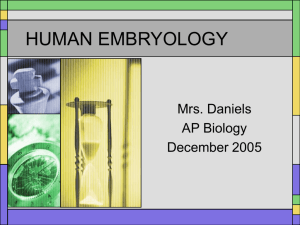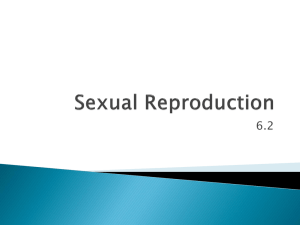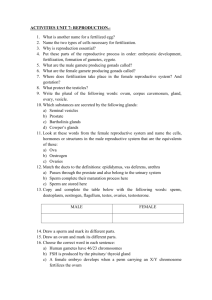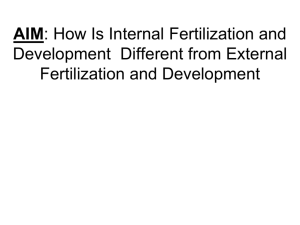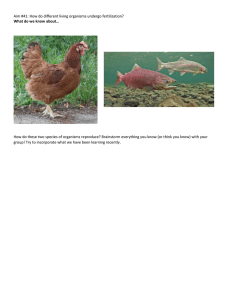Fertilization
advertisement
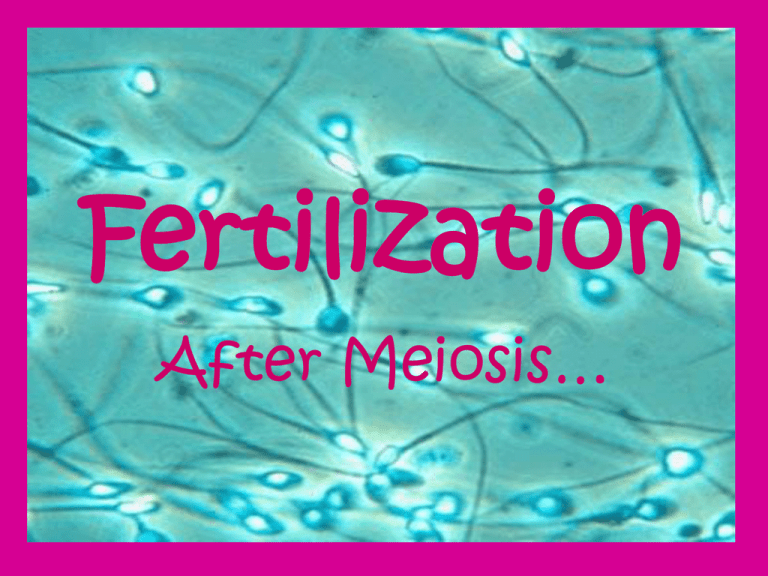
Fertilization After Meiosis… Gonads • Reproductive organs – Males have testes – Females have ovaries Gametes • Reproductive cells – Males have sperm – Females have eggs Variation in Offspring • You receive 23 chromosomes from your father and 23 chromosomes from your mother • Since you are a combination of two different individuals you are different from your parents • This is sexual reproduction – the combination of two haploid cells (23 in a human) to produce a diploid cell (zygote which contains 46 chromosomes) Sexual Reproduction • Gametes are produced via meiosis • The male gamete combines with a female gamete • A zygote is produced and develops into an embryo • The embryo develops through mitosis into a mature offspring (gestation varies from organism to organism) Fertilization only occurs if a sperm meets an egg from the same species. Mating Patterns • Some animals only mate once a year – Timed so that when offspring are born, the environmental conditions are favourable • Some fish mate only when the tides are high and during a full or new moon • Honeybees only mate once in a lifetime External Fertilization • External fertilization is when the gametes met outside of the parents • Sperm and eggs will dry out, so they must be kept in a moist environment • Sperm can only swim in a wet environment • Common in fish and amphibians Internal Fertilization • Common in most animals that live on land • Special reproductive structures are required for this – Intromittent organ in most birds – Cloaca • Sperm is transferred to the female via the male’s reproductive structure • Sperm travels inside of the female to reach the egg Laying Eggs or Internal Development • Some mammals will lay eggs and the foetus will develop outside of the female • Other mammals will continue to have the foetus develop inside of the female until is has developed into a mature offspring • This is called gestation Gestation of Various Mammals In Months Rabbit 1 Cat 2 Dog 2 Lion 3.5 Pig 4 Sheep 5 Human 9 Cow 9.5 Horse 11 Elephant 22 Pros vs. Cons • List some advantages of internal fertilization • List some advantages of external fertilization • List some disadvantages of internal fertilization • List some disadvantages of external fertilization Advantages of Internal Fertilization • Provides more nutrient investment into a single egg • Sexually selected physical traits • Provides a wet environment for the sperm and the egg • Temperature regulation • Fewer gametes are required to ensure fertilization occurs Advantages of External Fertilization • Requires very little effort as the sperm and egg can randomly meet • Female does not have to look after offspring once they are fertilized • A specialized structure is not required to have gametes meet Disadvantages of Internal Fertilization • Complex courtship and mating behaviours • Parents (usually female) must care for the young throughout gestation or until the eggs hatch • Specialized structures are required to ensure the meeting of gametes Disadvantages of External Fertilization • Large number of gametes must be produced to ensure mature offspring survive • Seasonal due to the delicate nature of the gametes • Many zygotes are produced but only a few survive


